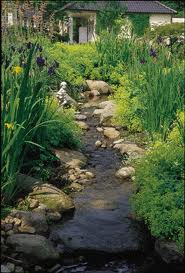





Streams can take on a number of aspects, depending upon their position and how they are constructed. A naturally occurring stream will be a great pleasure and, if long established, can rarely be improved upon, although radical changes to its surroundings may mean that some adjustments to it become necessary.

Often, a natural stream may have flowed through fields for centuries before housing development completely alters the way in which it contrasts with, and complements its surroundings. Doubtless, the way in which such a stream has contoured the landscape in its immediate vicinity will be appealing, but this must be carefully considered within the overall plan for the garden landscape. Small alterations to the flow, or a dam or diversion, can make all the difference to a natural stream’s appearance, although it is unwise to alter the flow of water into or out of a property without consuiting the relevant local authorities and anyone else who may be affected, such as your neighbours.
An artificial stream is much easier to deal with, and can often be readily accommodated in the garden landscape. However, it must have definite points to flow to and from, but should not end up as a simple straight or curved channel. If contriving a beginning and an end is difficult, use planting to disguise the arrangement.
A pool will often form the focal point, but it need not be at the end of the feature, as with a waterfall. It can easily be the point from which a stream flows and disappears behind a shrubby planting. If the level of the ground is awkward, cleverly arranged planting will make it possible to feed the stream underground and, by means of a simple submersible pump, persuade it to appear as a spring elsewhere.
Such a stream provides the sound of moving water, a wonderful environment for aquatic insect life, an opportunity to discreetly incorporate a filter, and a great chance to indulge in extensive waterside planting. If space is limited in the margins of the pool, a stream will make it possible to extend marginal planting throughout its length, for with an artificially constructed stream, creating reliable wet waterside growing conditions will be quite easy.
When introducing an artificial stream into the garden, take care in blending it into the landscape, especially with regard to the distribution of excavated soil. It may be tempting to dig out the stream and place the soil on the banks. In some cases, this may be acceptable, but for the most part, it creates a very artificial appearance, making the stream look like a canal. Observe natural streams in the countryside and try to emulate them. They have evolved as a result of water running through the softest or lowest ground, and have gradually carved out their passage. An artificial stream, even if intended to look man-made in a more formal setting, should still obey this simple rule if it is to be pleasing to the eye.
When considering a stream, do not forget the opportunities that it will provide for adding stepping stones or a bridge. Neither will be functional without flowing water, and their value as additional garden features should not be underestimated. Whether the simple stone clapper type or an elaborate oriental structure, a bridge can bring as much interest to a garden as a gazebo. If it is to be elaborate, make it a focal point and design your stream to meander beneath it.
Stepping stones are useful for crossing a stream, although few domestic gardeners will have a stream of sufficient size to warrant more than a couple. However, the stones themselves can be very pleasing to the eye and, in addition, may be cunningly employed to vary the flow of the stream and appearance of the water.
In terms of construction, a stream will look best if created in levels. In other words, the floor of the stream should be level for a certain distance before dropping, by means of a small waterfall or merely the depth of a stone, to a new level, and so on. The water will be pushed along by a pump, which may be switched off from time to time. When this occurs, it is very important for the appearance of the stream that it retains a certain amount of water. This also has a practical purpose, since the capacity of the stream system and pond will exceed that of the pond, leading to flooding if all the water is allowed to drain into the pond.
The same applies to rills and channels. The latter are very formal features, while the former are normally more natural looking, although they can be either. With a channel, everything will be much clearer and angular. Use it rather like a stream, but where appropriate, be eccentric. It is an artificial feature and can be employed to great advantage, especially in guiding visitors around the garden. Place a channel beside a path to lead the visitor on, but create side channels and surprises, dressing the feature with carefully selected plants to tease the eye.
Copyright © www.100flowers.win Botanic Garden All Rights Reserved